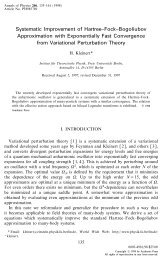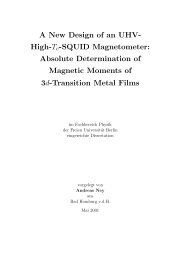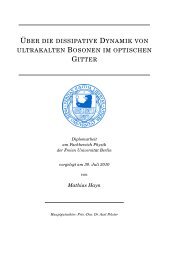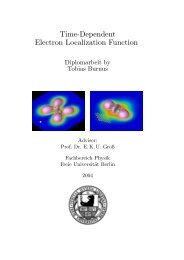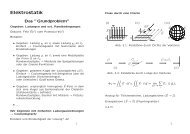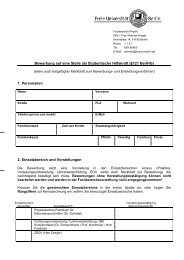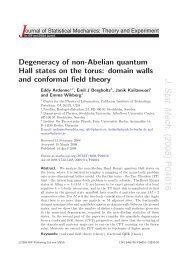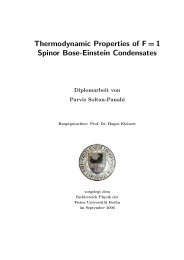Diploma thesis
Diploma thesis
Diploma thesis
You also want an ePaper? Increase the reach of your titles
YUMPU automatically turns print PDFs into web optimized ePapers that Google loves.
4.1 Static solutions of Schrödinger equation<br />
Thus the phase has to be ϕ = nπ, that is e iϕ = (−1) n , and we obtain the correct real limit<br />
√<br />
√<br />
ψ0 s 1<br />
(χ) = √ 1 π2<br />
2n<br />
(2n)! e− 2 χ2 H 2n (χ) ⇔ ψ0 s √ λ 1<br />
(√ )<br />
(x) =<br />
1 π 2 2n (2n)! e− 2 λx2 H 2n λx , (4.60)<br />
where λ 1 = λ 2 =: λ in the limit C → 0. The λ in the prefactor arises, because the integration has<br />
now to be performed with respect to x instead of χ = √ λx.<br />
4.1.1.4 Limit of vanishing waist<br />
Next we evaluate the special case ω → 0, that should directly correspond to the real limit just<br />
like for the square well potential, since in this particular limit area 2 and thus the region, where<br />
V I ≠ 0, vanishes. Therefore, only the familiar system of a real harmonic potential remains, which<br />
is, indeed, nothing else than the real limit. Thus we have to show that in the limit ω → 0 all<br />
area-1- and area-3-quantities of our complex system turn into the familiar form of the real system.<br />
Area 2 and its variables are not of any interest in this case but nevertheless we must derive a 1 and<br />
thus also ε from the quantization condition (4.37). Therefore we have to write down an expression<br />
of it in the limit ω → 0. To perform this we first need the limits of the following quantities:<br />
From them we conclude<br />
lim<br />
x→0 1 F 1 (a; c; x) = 1 ,<br />
√<br />
lim θ = lim 1 + ic<br />
ω→0 ω→0 ω = ∞ , 2<br />
lim a 2 = 1<br />
ω→0 4 . (4.61)<br />
lim<br />
ω→0 θω = √ ic ,<br />
lim θω 2 = 0. (4.62)<br />
ω→0<br />
Inserting these results into (4.37) yields the following condition for a 1 :<br />
2 Γ ( a 1 + 1 2<br />
Γ (a 1 )<br />
)<br />
= −2 lim ω Γ ( a 1 + 1 2<br />
ω→0 Γ (a 1 )<br />
)<br />
[√i c √<br />
2 − i c ]<br />
2<br />
⇔<br />
Γ ( a 1 + 1 2<br />
Γ (a 1 )<br />
)<br />
= 0. (4.63)<br />
This is only fulfilled if a 1 is equal to some negative natural number a 1 = −n, which indeed yields<br />
exactly the same result like in the real limit so that all the following steps can be adopted and we<br />
finally obtain for the limit of vanishing waist ω → 0 the familiar result:<br />
(<br />
E0 s = Ω 2n + 1 )<br />
, ψ s<br />
2<br />
1,0(x) =: ψ0(x) s =<br />
4.1.1.5 Limit of big waist<br />
√ √ λ<br />
π<br />
1<br />
2 2n (2n)! e− 1 2 λx2 H 2n<br />
(√<br />
λx<br />
)<br />
. (4.64)<br />
Similar to the limit of vanishing waist, that is ω → 0, we also evaluate the limit of big waist<br />
ω → ∞. To this end we rewrite the quantization condition (4.37) in the limit ω → ∞ and extract<br />
some information about a 2 and thus ε, since area 1 vanishes and thus a 1 is not important any<br />
45




